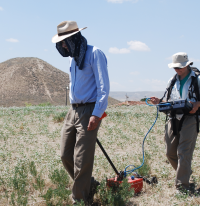Archäologie
Bildinfo und Lizenz
Bildinfo
- Archäologen in der Zentraltürkei suchen nach Knochen, Töpferware oder Gräbern. Radartechnik hilft dabei, Artefakte im Boden auch ohne Grabarbeit finden zu können. Die Archäologie verbindet oft modernste Technik mit einem Arbeiten im Gelände.
- Two NASA Earth scientists have traded in their air-conditioned offices for the sweltering fields of central Turkey. Toiling nine or more hours per day, seven days a week, they walk up to 10 miles a day searching ancient Turkey archaeological grounds for bone fragments, pottery and tombs. But they aren’t using shovels, picks, and brushes to do the job.
- Instead, scientists Compton Tucker from NASA’s Goddard Space Flight Center in Greenbelt, Md. and Joe Nigro, who works at Goddard through Science Systems and Application Inc., are combining NASA satellite data and ground penetrating radar (GPR) technology to map and protect areas of archaeological interest for an excavation project, located at the famed spot where Alexander the Great cut fabled King Midas’ Gordian knot. In the past, NASA radar has been used on satellites and spacecrafts to detect ice deposits and to explore deep canyons on the moons surface.
- “The radar assists in excavation by helping archaeologists identify areas where there are features under the ground, but GPR is also used as a non-invasive technique so that the site doesn’t have to be excavated,” said Joe Nigro, a geographic information systems specialist and archaeologist by training.
- Das Bild ist gegenüber dem Original von links nach rechts gespiegelt.
Source
- Date: Around the year 2010
- Author: Joe Nigro
- Credit: NASA
License
Diese Datei ist gemeinfrei (public domain), da sie von der NASA erstellt worden ist. Die NASA-Urheberrechtsrichtlinie besagt, dass "NASA-Material nicht durch Urheberrecht geschützt ist, wenn es nicht anders angegeben ist".
Originalseite
- Das Bild ist Teil eines online-Lexikons.
- Rhetos Lernlexikon Mathematik, Aachen:
- Siehe unter => Archäologie
 Archäologen in der Zentraltürkei suchen nach Knochen, Töpferware oder Gräbern. Radartechnik hilft dabei, Artefakte im Boden auch ohne Grabarbeit finden zu können. Die Archäologie verbindet oft modernste Technik mit einem Arbeiten im Gelände.
© Joe Nigro => Zurück zum Artikel
Archäologen in der Zentraltürkei suchen nach Knochen, Töpferware oder Gräbern. Radartechnik hilft dabei, Artefakte im Boden auch ohne Grabarbeit finden zu können. Die Archäologie verbindet oft modernste Technik mit einem Arbeiten im Gelände.
© Joe Nigro => Zurück zum Artikel